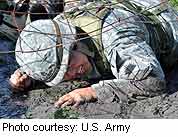- Double Mastectomy May Offer No Survival Benefit to Women With Breast Cancer
- Toxic Lead Found in Cinnamon Product, FDA Says
- Certain Abbott Blood Sugar Monitors May Give Incorrect Readings
- Athletes Can Expect High Ozone, Pollen Counts for Paris Olympics
- Fake Oxycontin Pills Widespread and Potentially Deadly: Report
- Shingles Vaccine Could Lower Dementia Risk
- Your Odds for Accidental Gun Death Rise Greatly in Certain States
- Kids From Poorer Families Less Likely to Survive Cancer
- Tough Workouts Won’t Trigger Cardiac Arrest in Folks With Long QT Syndrome
- At-Home Colon Cancer Test Can Save Lives
Spinal Injuries to Soldiers Much More Common in Iraq, Afghanistan Wars


FRIDAY, Sept. 20One in nine U.S. troops who suffered combat wounds in Iraq or Afghanistan had a spinal injury, a much higher rate than in previous wars, according to a new study.
Researchers analyzed U.S. Department of Defense casualty records from 2005 to 2009 and found that spinal injuries were present in 11 percent of nearly 7,900 troops wounded in combat in the two countries.
Fractures were involved in more than 80 percent of spinal injuries. Three-quarters of spinal injuries were caused by explosions and about 15 percent by gunshots, found the study in the Sept. 15 issue of the journal Spine.
About 3 percent of soldiers with spinal injuries died after receiving medical care. The study did not include those who died before receiving medical care.
Overall, spinal damage occurred at a rate of 4.4 injuries per 10,000 U.S. military personnel deployed to Iraq or Afghanistan, with a rate of four per 10,000 for spinal fractures. In contrast, the rate of injuries to limbs was about 15 per 10,000 troops, according to a journal news release.
Soldiers in Afghanistan were more likely to sustain spinal injuries than those in Iraq, and members of the Army were more likely to sustain the injuries than those in other branches of the military. The Iraq War “surge” year of 2007 resulted in the highest rate of spinal injuries. Gunshot-related spinal wounds were more common in Iraq than in Afghanistan.
“The 11.1 percent rate of spinal injuries represents the highest published statistic for Iraq, Afghanistan or any other American conflict,” said Dr. Andrew Schoenfeld, of the William Beaumont Army Medical Center in El Paso, Texas, and his colleagues.
They said the rate of spinal injuries is perhaps 10 times higher than in the Vietnam War. They noted that in previous wars, most soldiers with spinal trauma were injured so severely that they did not survive.
“Advances in military medicine are now enabling soldiers to reach medical facilities where their spinal wounds can be identified,” the study authors said.
More information
The U.S. National Institute of Neurological Disorders and Stroke has more about spinal cord injuries.
Source: HealthDay
Copyright © 2024 HealthDay. All rights reserved.










